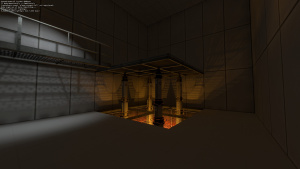Texture shadows: Difference between revisions
Jump to navigation
Jump to search
 Important:Only the alpha channels of the textures are used for shadow casting calculations. For example, stained glass windows using the Refract shader will be treated as opaque, as will materials using
Important:Only the alpha channels of the textures are used for shadow casting calculations. For example, stained glass windows using the Refract shader will be treated as opaque, as will materials using  Workaround:(only in
Workaround:(only in  ) Define a separate
) Define a separate
SirYodaJedi (talk | contribs) No edit summary |
SirYodaJedi (talk | contribs) No edit summary |
||
| Line 1: | Line 1: | ||
[[File:Textureshadows portal2.jpg|thumb|right|Texture shadows in Portal 2]] | [[File:Textureshadows portal2.jpg|thumb|right|Texture shadows in Portal 2]] | ||
Texture shadows [[model]] surfaces (not brushes or displacements!) to cast baked lightmap shadows based upon transparency or translucency | Texture shadows [[model]] surfaces (not brushes or displacements!) to cast baked lightmap shadows based upon transparency or translucency of the {{cmd|$basetexture}} of materials with {{cmd|$alphatest}} or {{cmd|$translucent}}. | ||
To enable model texture shadows, add {{code|-TextureShadows}} to the [[VRAD]] parameters. | To enable model texture shadows, add {{code|-TextureShadows}} to the [[VRAD]] parameters. | ||
{{only|{{slammin}}}} To enable brush and displacement texture shadows, add {{code|-worldtextureshadows}} (and optionally {{code|-translucentshadows}} for translucent shadows) to the [[VRAD]] parameters. | {{only|{{slammin}}}} To enable brush and displacement texture shadows, add {{code|-worldtextureshadows}} (and optionally {{code|-translucentshadows}} for translucent shadows) to the [[VRAD]] parameters. | ||
{{Bug|{{slammin}} {{code|-worldtextureshadows}} and {{code|-translucentshadows}} | {{Bug|{{slammin}} {{code|-worldtextureshadows}} and {{code|-translucentshadows}} don't work correctly if the top left pixel is completely opaque.|tested=newer versions of {{slammin}} VRAD}} | ||
{{modernImportant|Only the alpha channels of the textures are used for shadow casting calculations. For example, stained glass windows using the {{ent|Refract}} shader will be treated as opaque, as will materials using {{cmd|$additive}} without {{cmd|$translucent}}.}} | {{modernImportant|Only the alpha channels of the textures are used for shadow casting calculations. For example, stained glass windows using the {{ent|Refract}} shader will be treated as opaque, as will materials using {{cmd|$additive}} without {{cmd|$translucent}}.{{workaround|{{gmod|only}} Define a separate {{cmd|%alphatexture}} to use for casting shadows.}} }} | ||
{{bug|VRAD is unable to calculate texture shadows for textures using DXT3 compression. Use DXT5 instead.|tested={{hl2dm}}}} | {{bug|VRAD is unable to calculate texture shadows for textures using DXT3 compression. Use DXT5 instead.|tested={{hl2dm}}}} | ||
Revision as of 09:16, 3 April 2025
Texture shadows model surfaces (not brushes or displacements!) to cast baked lightmap shadows based upon transparency or translucency of the $basetexture of materials with $alphatest or $translucent.
To enable model texture shadows, add -TextureShadows to the VRAD parameters.
(only in ![]() ) To enable brush and displacement texture shadows, add
) To enable brush and displacement texture shadows, add -worldtextureshadows (and optionally -translucentshadows for translucent shadows) to the VRAD parameters.
$additive without $translucent.%alphatexture to use for casting shadows.Models
In QC
Add $casttextureshadows to the model's QC file to enable texture shadows.
Example:
$modelname "props_grate/metal_grate_64.mdl" $model body "metal_grate_64.smd" $staticprop $cdmaterials "metal/" $surfaceprop "metal" $contents "grate" $casttextureshadows
lights.rad
Texture shadows can be enabled on any prop without editing and recompiling the QC through the RAD file.
Example
forcetextureshadow props_underground/walkway_128a.mdl forcetextureshadow props_underground/walkway_128b.mdl
